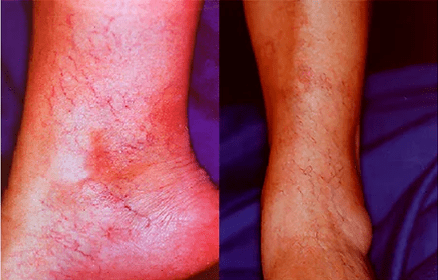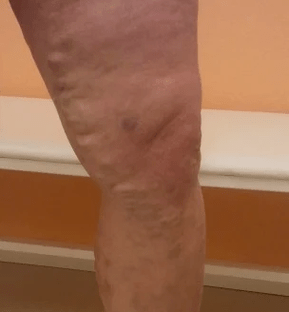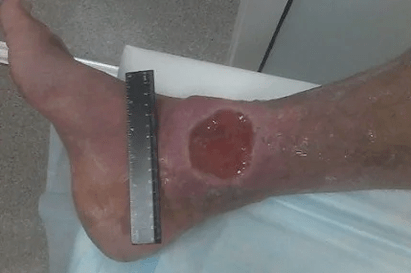
Varicose veins - This is the expansion of subcutaneous veins with a diameter of more than 3 mm.Varicose veins develops due to impaired operation of the venous valves and weakness of the venous wall;At the same time, the outflow of blood from the lower extremities, an increase in pressure inside the vein, which can lead to chronic venous insufficiency occurs.
Sometimes, telanggiectasia and reticular veins are mistaken for varicose-open.
These are veins with diameter 3 mm and less, they do not affect the venous outflow, but cause a clear cosmetic defect.
What is the prevalence of varicose veins?
Varicose expansion of subcutaneous veins is present in 30 % of women and in 15 % of men of mature age.The prevalence of varicose veins of the lower extremities increases markedly with age and is present in most people over the age of 60.The proportion of patients with trophic disorders in adulthood is only 1.8%, while in old age the indicator reaches 20%.At the same time, every fifth patient in life is faced with thrombophlebitis.Among the reasons leading to disability, the share of disabled forms of veins of veins is more than arteries.
The main risk factors for the development of varicose veins are:
- elderly age
- Female gender
- pregnancy
- Hormonal disorders
- Positive family history
Additional risk factors:
- smoking
- Arterial hypertension
- constipation
The literature on additional risk factors are contradictory.Moreover, the risk of developing venous disease is low.
How is varicose veins manifested?

The most frequent manifestation is unevenly dilated veins protruding above the surface.In some cases, they can be barely noticeable or determined only by touch, in others they take a winding form with the formation of nodes or in appearance resemble a large grape bunch.
Often varicose veins are accompanied by the following symptoms:
- Feeling and tension in the legs
- Pain pulling and/or aching along the veins
- Fast fatigue of the legs
- Itching of the skin of the legs
Rarely varicose disease can cause restless legs syndrome and nightly leg cramps.
What are the dangers of the progression of varicose veins?
In the absence of treatment, the progression of varicose veins can lead to chronic venous insufficiency (CVN).The presence of HVN indicates severe violations of the lymph venous return (clinical classes C3-C6 CEAP classification), which include: chronic edema (lymphedem), skin color change (hyperpigmentation), venous eczema, skin compaction, trophic venous ulcer.
What are the complications of varicose veins?
Thromboflebitis-the formation of a thrombus in a surface venous system is an event that is faced with 20% of patients with varicose veins.Such thrombosis is accompanied by severe pain, redness of the skin, sealing along the vein on the lower leg and/or thigh.In the absence of treatment, thrombotic masses are possible to a deep venous system.

Deep vein thrombosis (TGV) - In most cases, the beginning of the process is asymptomatic.When thrombosis is spreading to the femoral segment and the vein of the pelvis, the main outflow of blood from the lower extremities is disturbed, which is accompanied by severe edema and pain syndrome and is regarded as a life -threatening situation.
Tromboembolism of the pulmonary arteries (TELA) - In 10% of cases, thrombotic masses in deep veins of the lower extremities are fragmented and migrated to the pulmonary arteries with a blood flow, causing deaths.
What is needed for the correct diagnosis?
Given the variety of forms of vein diseases, every detail of the history of the development of the disease and the life of the patient, the presence of concomitant diseases, transactions, the result of an external examination by a doctor and the most important thing is ultrasound, ultrasound, the Ultrasound Dulectic scanning of veins, is important to make a correct diagnosis.The latter, today, is the most informative accurate and non -invasive method of studying the veins of the lower extremities.
Varicose veins treatment, the most common methods:
- Drug treatment-vein-toning drugs have proven their effectiveness in reducing the symptoms of varicose veins, but they are not able to eliminate varicose veins on their own.Pharmacotherapy is successfully used to prevent complications in risk groups, preoperative preparation and postoperative rehabilitation.
- Compression treatment - Wearing special medical knitwear in the form of golf, stocking, tights.In some cases, multi -layer bandaging with elastic bandages of various extensions and hardware pneumo compression are used.The role of compression treatment is difficult to overestimate, it is present at almost every stage of the prevention and treatment of chronic veins.
- Introduction to the lumen of the veins of drugs that can cause its closure.This method is a gold standard for eliminating reticular veins.It is successfully used in the treatment of varicose veins of not a large diameter and has restrictions in eliminating the pathological blood flow of the main subcutaneous veins.
- Classic operation - Combined phlebectomy, in modern performance is performed on an outpatient basis under spinal or local anesthesia.In some cases, this is the only feasible way when the target veins are very convincing and/or have high extensions.However, the method is inferior to endo vascular traumatic procedures.
- Endo venous laser prison - A method for treating varicose veins, in which the vein is not removed, but is closed from the inside with the energy of laser radiation, which is brought directly into the vessel of wholesale with a fiber.The effectiveness of the procedure is comparable to the results of surgical removal of the vein, at the same time, it is characterized by minimal trauma.Rehabilitation time is 1-3 days.
- Radio frequency prison - a progressive way to eliminate pathological blood flow of trunk subcutaneous veins.This is a completely outpatient procedure performed under local anesthesia.The effectiveness of treatment corresponds to the level of classic phlebectomy, the pain syndrome is minimal or absent.Rehabilitation time is 1-2 days.












































